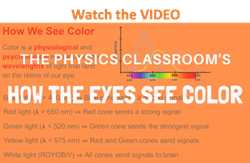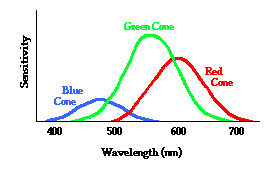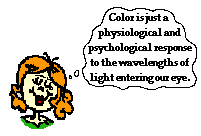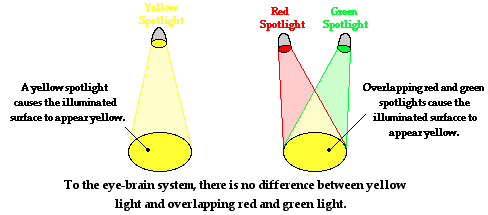Hold down the T key for 3 seconds to activate the audio accessibility mode, at which point you can click the K key to pause and resume audio. Useful for the Check Your Understanding and See Answers.
 As mentioned in the first section of Lesson 2, our eyes are sensitive to a very narrow band of frequencies within the enormous range of frequencies of the electromagnetic spectrum. This narrow band of frequencies is referred to as the visible light spectrum. Visible light - that which is detectable by the human eye - consists of wavelengths ranging from approximately 780 nanometer (7.80 x 10-7 m) down to 390 nanometer (3.90 x 10-7 m). Specific wavelengths within the spectrum correspond to a specific color based upon how humans typically perceive light of that wavelength. The long wavelength end of the spectrum corresponds to light that is perceived by humans to be red and the short wavelength end of the spectrum corresponds to light that is perceived to be violet. Other colors within the spectrum include orange, yellow, green and blue. The graphic below depicts the approximate range of wavelengths that are associated with the various perceived colors within the spectrum.
As mentioned in the first section of Lesson 2, our eyes are sensitive to a very narrow band of frequencies within the enormous range of frequencies of the electromagnetic spectrum. This narrow band of frequencies is referred to as the visible light spectrum. Visible light - that which is detectable by the human eye - consists of wavelengths ranging from approximately 780 nanometer (7.80 x 10-7 m) down to 390 nanometer (3.90 x 10-7 m). Specific wavelengths within the spectrum correspond to a specific color based upon how humans typically perceive light of that wavelength. The long wavelength end of the spectrum corresponds to light that is perceived by humans to be red and the short wavelength end of the spectrum corresponds to light that is perceived to be violet. Other colors within the spectrum include orange, yellow, green and blue. The graphic below depicts the approximate range of wavelengths that are associated with the various perceived colors within the spectrum.

Color Cones
Color can be thought of as a psychological and physiological response to light waves of a specific frequency or set of frequencies impinging upon the eye. An understanding of the human response to color demands that one understand the biology of the eye. Light that enters the eye through the pupil ultimately strikes the inside surface of the eye known as the retina. The retina is lined with a variety of light sensing cells known as rods and cones. While the rods on the retina are sensitive to the intensity of light, they cannot distinguish between lights of different wavelengths. On the other hand, the cones are the color-sensing cells of the retina. When light of a given wavelength enters the eye and strikes the cones of the retina, a chemical reaction is activated that results in an electrical impulse being sent along nerves to the brain. It is believed that there are three kinds of cones, each sensitive to its own range of wavelengths within the visible light spectrum. These three kinds of cones are referred to as red cones, green cones, and blue cones because of their respective sensitivity to the wavelengths of light that are associated with red, green and blue. Since the red cone is sensitive to a range of wavelengths, it is not only activated by wavelengths of red light, but also (to a lesser extent) by wavelengths of orange light, yellow light and even green light. In the same manner, the green cone is most sensitive to wavelengths of light associated with the color green. Yet the green cone can also be activated by wavelengths of light associated with the colors yellow and blue. The graphic below is a sensitivity curve that depicts the range of wavelengths and the sensitivity level for the three kinds of cones.

The cone sensitivity curve shown above helps us to better understand our response to the light that is incident upon the retina. While the response is activated by the physics of light waves, the response itself is both physiological and psychological. Suppose that white light - i.e., light consisting of the full range of wavelengths within the visible light spectrum - is incident upon the retina. Upon striking the retina, the  physiological occurs: photochemical reactions occur within the cones to produce electrical impulses that are sent along nerves to the brain. The cones respond to the incident light by sending a message forward to brain, saying, "Light is hitting me." Upon reaching the brain, the psychological occurs: the brain detects the electrical messages being sent by the cones and interprets the meaning of the messages. The brain responds by saying "it is white." For the case of white light entering the eye and striking the retina, each of the three kinds of cones would be activated into sending the electrical messages along to the brain. And the brain recognizes that the messages are being sent by all three cones and somehow interprets this to mean that white light has entered the eye.
physiological occurs: photochemical reactions occur within the cones to produce electrical impulses that are sent along nerves to the brain. The cones respond to the incident light by sending a message forward to brain, saying, "Light is hitting me." Upon reaching the brain, the psychological occurs: the brain detects the electrical messages being sent by the cones and interprets the meaning of the messages. The brain responds by saying "it is white." For the case of white light entering the eye and striking the retina, each of the three kinds of cones would be activated into sending the electrical messages along to the brain. And the brain recognizes that the messages are being sent by all three cones and somehow interprets this to mean that white light has entered the eye.
Now suppose that light in the yellow range of wavelengths (approximately 577 nm to 597 nm) enters the eye and strikes the retina. Light with these wavelengths would activate both the green and the red cones of the retina. Upon striking the retina, the physiological occurs: electrical messages are sent by both the red and the green cones to the brain. Once received by the brain, the psychological occurs: the brain recognizes that the light has activated both the red and the green cones and somehow interprets this to mean that the object is yellow. In this sense, the yellow appearance of objects is simply the result of yellow light from the object entering our eye and stimulating the red and the green cones simultaneously.
If the appearance of yellow is perceived of an object when it activates the red and the green cones simultaneously, then what appearance would result if two overlapping red and green spotlights entered our eye? Using the same three-cone theory, we could make some predictions of the result. Red light entering our eye would mostly activate the red color cone; and green light entering our eye would mostly activate the green color cone. Each cone would send their usual electrical messages to the brain. If the brain has been psychologically trained to interpret these two signals to mean "yellow", then the brain would perceive the overlapping red and green spotlights to appear as yellow. To the eye-brain system, there is no difference in the physiological and psychological response to yellow light and a mixing of red and green light. The brain has no means of distinguishing between the two physical situations.

In a technical sense, it is really not appropriate to refer to light as being colored. Light is simply a wave with a specific wavelength or a mixture of wavelengths; it has no color in and of itself. An object that is emitting or reflecting light to our eye appears to have a specific color as the result of the eye-brain response to the  wavelength. So technically, there is really no such thing as yellow light. Rather, there is light with a wavelength of about 590 nm that appears yellow. And there is also light with a mixture of wavelengths of about 700 nm and 530 nm that together appears yellow. The yellow appearance of these two clearly different light sources can be traced to the physiological and psychological response of the eye-brain system, and not to the light itself. So to be technically appropriate, a person would refer to "yellow light" as "light that creates a yellow appearance." Yet, to maintain a larger collection of friendships, a person would refer to "yellow light" as "yellow light."
wavelength. So technically, there is really no such thing as yellow light. Rather, there is light with a wavelength of about 590 nm that appears yellow. And there is also light with a mixture of wavelengths of about 700 nm and 530 nm that together appears yellow. The yellow appearance of these two clearly different light sources can be traced to the physiological and psychological response of the eye-brain system, and not to the light itself. So to be technically appropriate, a person would refer to "yellow light" as "light that creates a yellow appearance." Yet, to maintain a larger collection of friendships, a person would refer to "yellow light" as "yellow light."
In the next several sections of Lesson 2, we will explore these concepts further by introducing three primary colors of light and generating some simple rules for predicting the color appearance of objects in terms of the three primary colors.
Investigate!
In this lesson we will spend a lot of time discussing three light colors - red, green, and blue. We will perceive light as consisting of red, green and blue qualities. Use the RGB widget below to determine the ratios by which red, green and blue light combine to form other light colors. Enter the name of a color (maize, purple, orange, sky blue, etc.) into the field. Then click the Submit button to find out its red, green, and blue components.
We Would Like to Suggest ...

Sometimes it isn't enough to just read about it. You have to interact with it! And that's exactly what you do when you use one of The Physics Classroom's Interactives. We would like to suggest that you combine the reading of this page with the use of our
RGB Color Addition Interactive. The Interactive is found in the Physics Interactives section of our website and allows a learner to adjust the intensity of red, green, and blue spotlights shining upon a white surface and to observe the appearance.